CBI NUR242: Acute Coronary Syndrome Management Report
VerifiedAdded on 2022/12/29
|11
|2575
|61
Report
AI Summary
This report focuses on the management of Acute Coronary Syndrome (ACS), a condition characterized by chest pain and potential myocardial ischemia. The report provides a background on ACS, explaining its causes, symptoms, and complications. It then reviews the current nursing practice standard ...
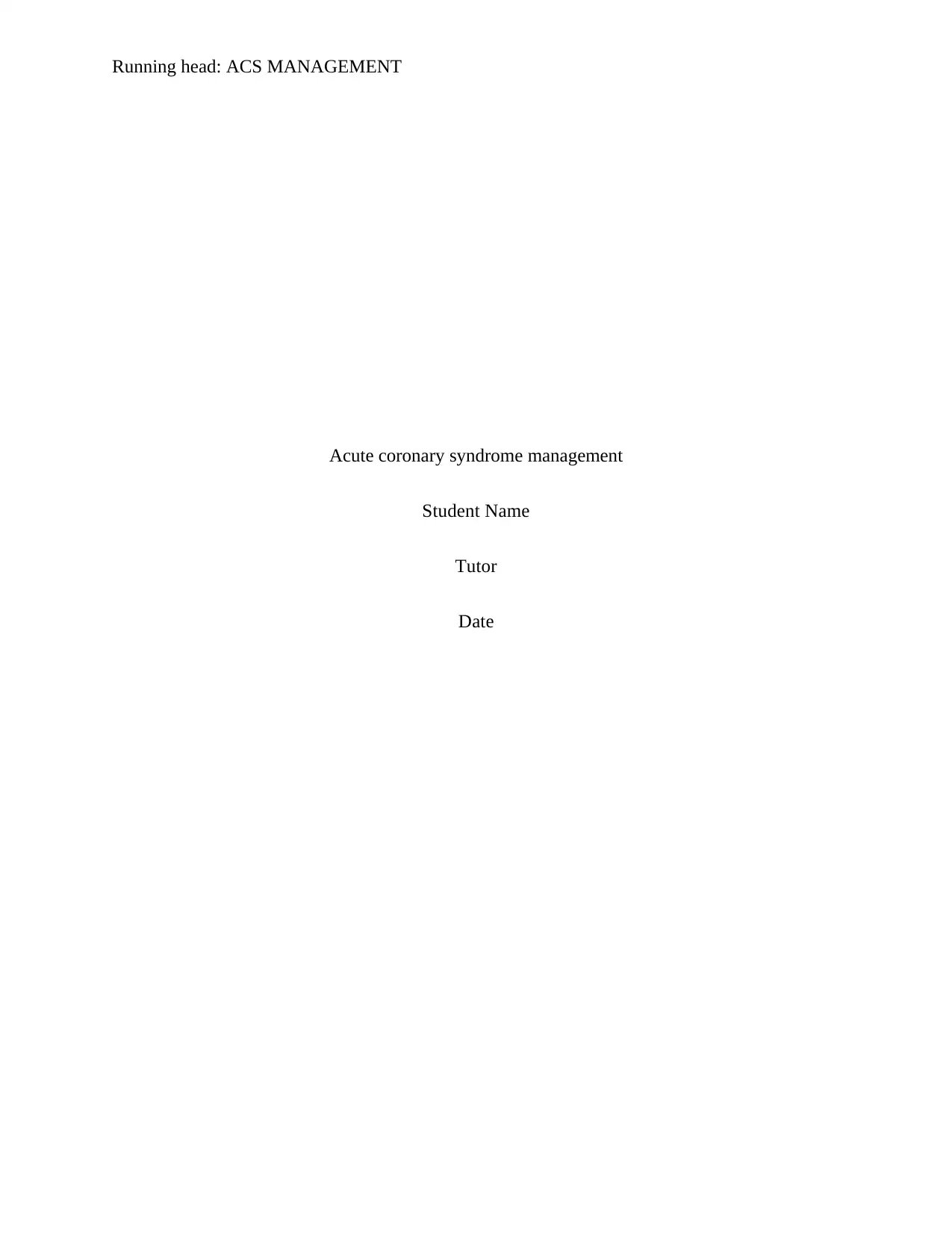
Running head: ACS MANAGEMENT
Acute coronary syndrome management
Student Name
Tutor
Date
Acute coronary syndrome management
Student Name
Tutor
Date
Paraphrase This Document
Need a fresh take? Get an instant paraphrase of this document with our AI Paraphraser

ACS MANAGEMENT 2
Title of Nursing Practice Standard
Chest pain: Confirmed and Suspected acute ACS management.
Background
An ACS comprises of the medical signs and symptoms or a collection of symptoms and
signs that are led by blockage of the coronary arteries. These clinical symptoms are well matched
with acute myocardial ischemia and consist of non–ST-NSTEMI, unsteady angina (UA) as well
as ST-STEMI (Ranya et al., 2018). An acute coronary syndrome (ACS) is associated with
electrocardiographic abnormalities, chest pain that may involve pressure, tightness or fullness,
dyspnea nausea as well as sweating (Parodi et al., 2016). In many cases, acute coronary
syndrome is caused by obstruction of the coronary artery mostly because of fatty deposits on the
wall or inside these important blood vessels that transports oxygen and nutrients to the heart
muscles (Rashid et al., 2016). A blood clot that inhibits the flow of blood in coronary artery is
formed when these fatty deposits ruptures. When they are not supplied with enough oxygen, the
cells in the heart muscles can die; as a result, the muscle tissues are damaged and this leads to
heart attack or myocardial infarction. Although insufficient oxygen supply to the heart muscles
do not lead to death of the heart muscles cell at all times, it still causes ineffectiveness in the
functions of the heart muscles, which can be temporary or long lasting.
After acute coronary syndrome has occurred, it causes complications such as electrical
dysfunction which include defects in conduction as well as irregular heartbeat. Another problem
that is associated with ACS is myocardial dysfunction such as ventricular aneurysm, heart
failure, pseudoaneurysm, free wall rupture or interventricular septum, cardiogenic shock and
mural thrombus formation. Another dysfunction associated acute coronary syndrome is the
Title of Nursing Practice Standard
Chest pain: Confirmed and Suspected acute ACS management.
Background
An ACS comprises of the medical signs and symptoms or a collection of symptoms and
signs that are led by blockage of the coronary arteries. These clinical symptoms are well matched
with acute myocardial ischemia and consist of non–ST-NSTEMI, unsteady angina (UA) as well
as ST-STEMI (Ranya et al., 2018). An acute coronary syndrome (ACS) is associated with
electrocardiographic abnormalities, chest pain that may involve pressure, tightness or fullness,
dyspnea nausea as well as sweating (Parodi et al., 2016). In many cases, acute coronary
syndrome is caused by obstruction of the coronary artery mostly because of fatty deposits on the
wall or inside these important blood vessels that transports oxygen and nutrients to the heart
muscles (Rashid et al., 2016). A blood clot that inhibits the flow of blood in coronary artery is
formed when these fatty deposits ruptures. When they are not supplied with enough oxygen, the
cells in the heart muscles can die; as a result, the muscle tissues are damaged and this leads to
heart attack or myocardial infarction. Although insufficient oxygen supply to the heart muscles
do not lead to death of the heart muscles cell at all times, it still causes ineffectiveness in the
functions of the heart muscles, which can be temporary or long lasting.
After acute coronary syndrome has occurred, it causes complications such as electrical
dysfunction which include defects in conduction as well as irregular heartbeat. Another problem
that is associated with ACS is myocardial dysfunction such as ventricular aneurysm, heart
failure, pseudoaneurysm, free wall rupture or interventricular septum, cardiogenic shock and
mural thrombus formation. Another dysfunction associated acute coronary syndrome is the
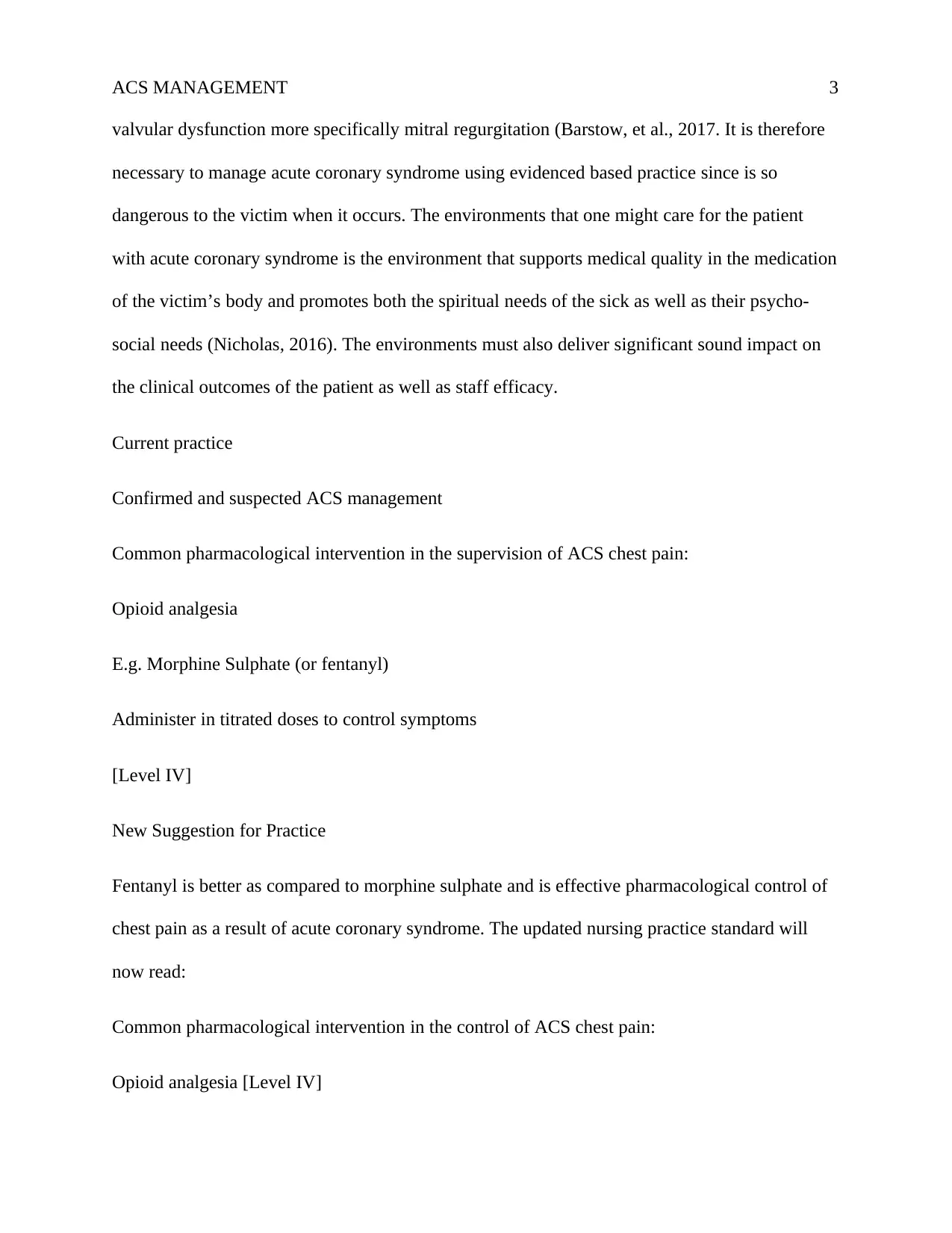
ACS MANAGEMENT 3
valvular dysfunction more specifically mitral regurgitation (Barstow, et al., 2017. It is therefore
necessary to manage acute coronary syndrome using evidenced based practice since is so
dangerous to the victim when it occurs. The environments that one might care for the patient
with acute coronary syndrome is the environment that supports medical quality in the medication
of the victim’s body and promotes both the spiritual needs of the sick as well as their psycho-
social needs (Nicholas, 2016). The environments must also deliver significant sound impact on
the clinical outcomes of the patient as well as staff efficacy.
Current practice
Confirmed and suspected ACS management
Common pharmacological intervention in the supervision of ACS chest pain:
Opioid analgesia
E.g. Morphine Sulphate (or fentanyl)
Administer in titrated doses to control symptoms
[Level IV]
New Suggestion for Practice
Fentanyl is better as compared to morphine sulphate and is effective pharmacological control of
chest pain as a result of acute coronary syndrome. The updated nursing practice standard will
now read:
Common pharmacological intervention in the control of ACS chest pain:
Opioid analgesia [Level IV]
valvular dysfunction more specifically mitral regurgitation (Barstow, et al., 2017. It is therefore
necessary to manage acute coronary syndrome using evidenced based practice since is so
dangerous to the victim when it occurs. The environments that one might care for the patient
with acute coronary syndrome is the environment that supports medical quality in the medication
of the victim’s body and promotes both the spiritual needs of the sick as well as their psycho-
social needs (Nicholas, 2016). The environments must also deliver significant sound impact on
the clinical outcomes of the patient as well as staff efficacy.
Current practice
Confirmed and suspected ACS management
Common pharmacological intervention in the supervision of ACS chest pain:
Opioid analgesia
E.g. Morphine Sulphate (or fentanyl)
Administer in titrated doses to control symptoms
[Level IV]
New Suggestion for Practice
Fentanyl is better as compared to morphine sulphate and is effective pharmacological control of
chest pain as a result of acute coronary syndrome. The updated nursing practice standard will
now read:
Common pharmacological intervention in the control of ACS chest pain:
Opioid analgesia [Level IV]
You're viewing a preview
Unlock full access by subscribing today!

ACS MANAGEMENT 4
E.g. fentanyl
Administer in titrated does to control symptoms but avoid sedation respiratory depression [Level
IV]
Rationale
Morphine is the original opioid on which all beginners are examined. Notwithstanding an
era of opioid study, there is no proof that any opioid that is synthetic is more efficient in regulati
ng pain compared morphine. If it were not for the release of histamine-intermediated
hypertension monitored intraoperatively with greater doses of morphine, it is possible fentanyl
would not have substituted morphine as the most frequently utilized anesthesia opioid in
practice. A crucial information concerning to morphine’s clinical pharmacology is its sluggish
commencement period. The drug’s pKa makes it nearly ionized at physiologic pH. This
characteristic, integrated with its minimum solubility, seemingly accounts or morphine’s
extended latency to topmost effect. This insinuates that morphine is less probable to cause acute
respiratory depression after injection of bolus of normal analgesics doses contrasted with the
more swift acting medicine since the association between partial pressure of carbon dioxide and
ventilation adjusts gradually.
The drug is used to assist in relieving severe to moderate pain. Acute coronary syndrome
is dangerous especially because of the chest pain, which appears in the sternum. Therefore, while
offering a therapy to a victim of acute coronary syndrome, the primary therapy should aim much
on balancing the patient’s condition mostly by reducing the chest pain as well as giving
antithrombotic treatment in order to decrease the myocardial harm and hinder more ischemia
(Abdi et al., 2016). One of the ways that is utilized to fulfil this objective is through efficient
E.g. fentanyl
Administer in titrated does to control symptoms but avoid sedation respiratory depression [Level
IV]
Rationale
Morphine is the original opioid on which all beginners are examined. Notwithstanding an
era of opioid study, there is no proof that any opioid that is synthetic is more efficient in regulati
ng pain compared morphine. If it were not for the release of histamine-intermediated
hypertension monitored intraoperatively with greater doses of morphine, it is possible fentanyl
would not have substituted morphine as the most frequently utilized anesthesia opioid in
practice. A crucial information concerning to morphine’s clinical pharmacology is its sluggish
commencement period. The drug’s pKa makes it nearly ionized at physiologic pH. This
characteristic, integrated with its minimum solubility, seemingly accounts or morphine’s
extended latency to topmost effect. This insinuates that morphine is less probable to cause acute
respiratory depression after injection of bolus of normal analgesics doses contrasted with the
more swift acting medicine since the association between partial pressure of carbon dioxide and
ventilation adjusts gradually.
The drug is used to assist in relieving severe to moderate pain. Acute coronary syndrome
is dangerous especially because of the chest pain, which appears in the sternum. Therefore, while
offering a therapy to a victim of acute coronary syndrome, the primary therapy should aim much
on balancing the patient’s condition mostly by reducing the chest pain as well as giving
antithrombotic treatment in order to decrease the myocardial harm and hinder more ischemia
(Abdi et al., 2016). One of the ways that is utilized to fulfil this objective is through efficient
Paraphrase This Document
Need a fresh take? Get an instant paraphrase of this document with our AI Paraphraser
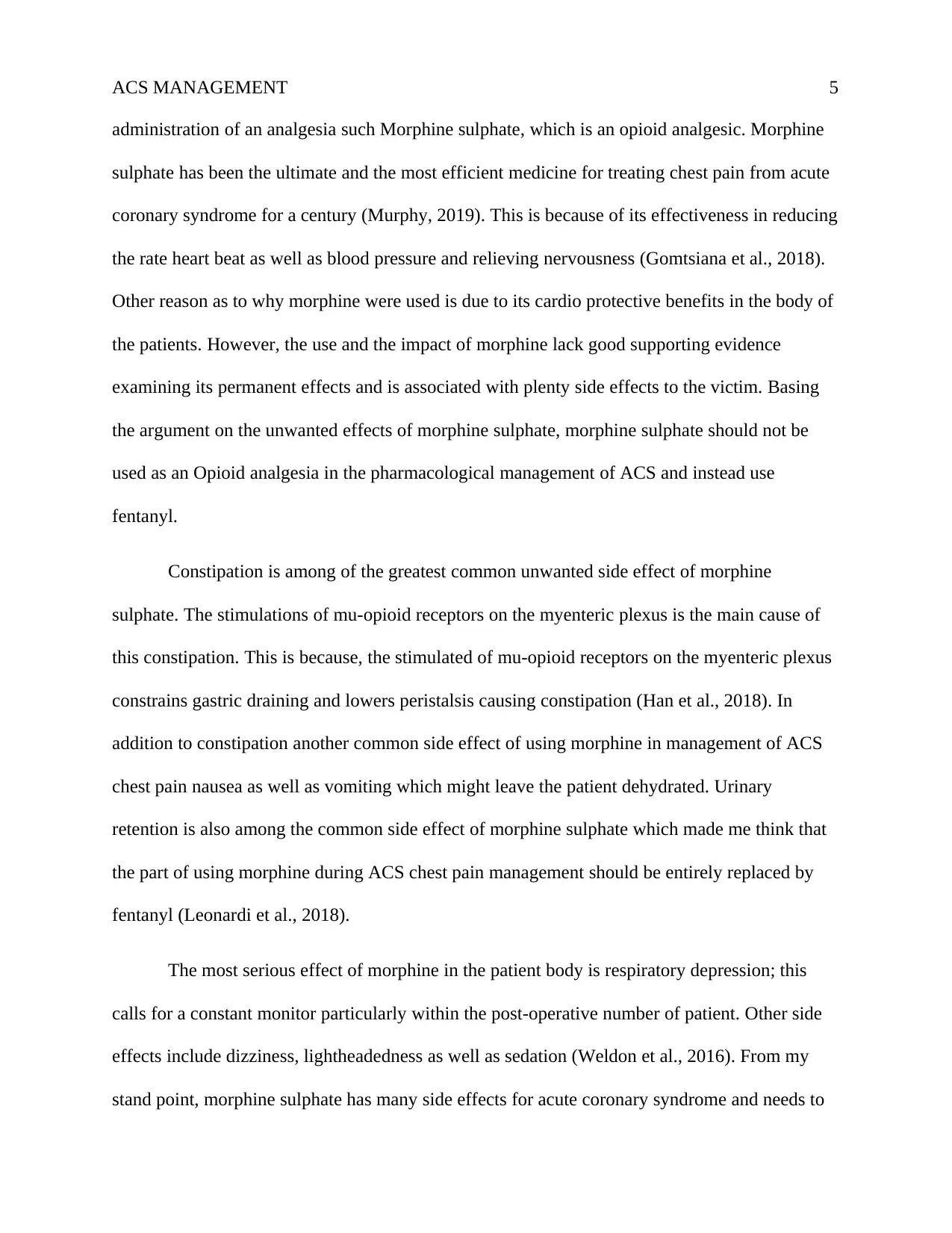
ACS MANAGEMENT 5
administration of an analgesia such Morphine sulphate, which is an opioid analgesic. Morphine
sulphate has been the ultimate and the most efficient medicine for treating chest pain from acute
coronary syndrome for a century (Murphy, 2019). This is because of its effectiveness in reducing
the rate heart beat as well as blood pressure and relieving nervousness (Gomtsiana et al., 2018).
Other reason as to why morphine were used is due to its cardio protective benefits in the body of
the patients. However, the use and the impact of morphine lack good supporting evidence
examining its permanent effects and is associated with plenty side effects to the victim. Basing
the argument on the unwanted effects of morphine sulphate, morphine sulphate should not be
used as an Opioid analgesia in the pharmacological management of ACS and instead use
fentanyl.
Constipation is among of the greatest common unwanted side effect of morphine
sulphate. The stimulations of mu-opioid receptors on the myenteric plexus is the main cause of
this constipation. This is because, the stimulated of mu-opioid receptors on the myenteric plexus
constrains gastric draining and lowers peristalsis causing constipation (Han et al., 2018). In
addition to constipation another common side effect of using morphine in management of ACS
chest pain nausea as well as vomiting which might leave the patient dehydrated. Urinary
retention is also among the common side effect of morphine sulphate which made me think that
the part of using morphine during ACS chest pain management should be entirely replaced by
fentanyl (Leonardi et al., 2018).
The most serious effect of morphine in the patient body is respiratory depression; this
calls for a constant monitor particularly within the post-operative number of patient. Other side
effects include dizziness, lightheadedness as well as sedation (Weldon et al., 2016). From my
stand point, morphine sulphate has many side effects for acute coronary syndrome and needs to
administration of an analgesia such Morphine sulphate, which is an opioid analgesic. Morphine
sulphate has been the ultimate and the most efficient medicine for treating chest pain from acute
coronary syndrome for a century (Murphy, 2019). This is because of its effectiveness in reducing
the rate heart beat as well as blood pressure and relieving nervousness (Gomtsiana et al., 2018).
Other reason as to why morphine were used is due to its cardio protective benefits in the body of
the patients. However, the use and the impact of morphine lack good supporting evidence
examining its permanent effects and is associated with plenty side effects to the victim. Basing
the argument on the unwanted effects of morphine sulphate, morphine sulphate should not be
used as an Opioid analgesia in the pharmacological management of ACS and instead use
fentanyl.
Constipation is among of the greatest common unwanted side effect of morphine
sulphate. The stimulations of mu-opioid receptors on the myenteric plexus is the main cause of
this constipation. This is because, the stimulated of mu-opioid receptors on the myenteric plexus
constrains gastric draining and lowers peristalsis causing constipation (Han et al., 2018). In
addition to constipation another common side effect of using morphine in management of ACS
chest pain nausea as well as vomiting which might leave the patient dehydrated. Urinary
retention is also among the common side effect of morphine sulphate which made me think that
the part of using morphine during ACS chest pain management should be entirely replaced by
fentanyl (Leonardi et al., 2018).
The most serious effect of morphine in the patient body is respiratory depression; this
calls for a constant monitor particularly within the post-operative number of patient. Other side
effects include dizziness, lightheadedness as well as sedation (Weldon et al., 2016). From my
stand point, morphine sulphate has many side effects for acute coronary syndrome and needs to
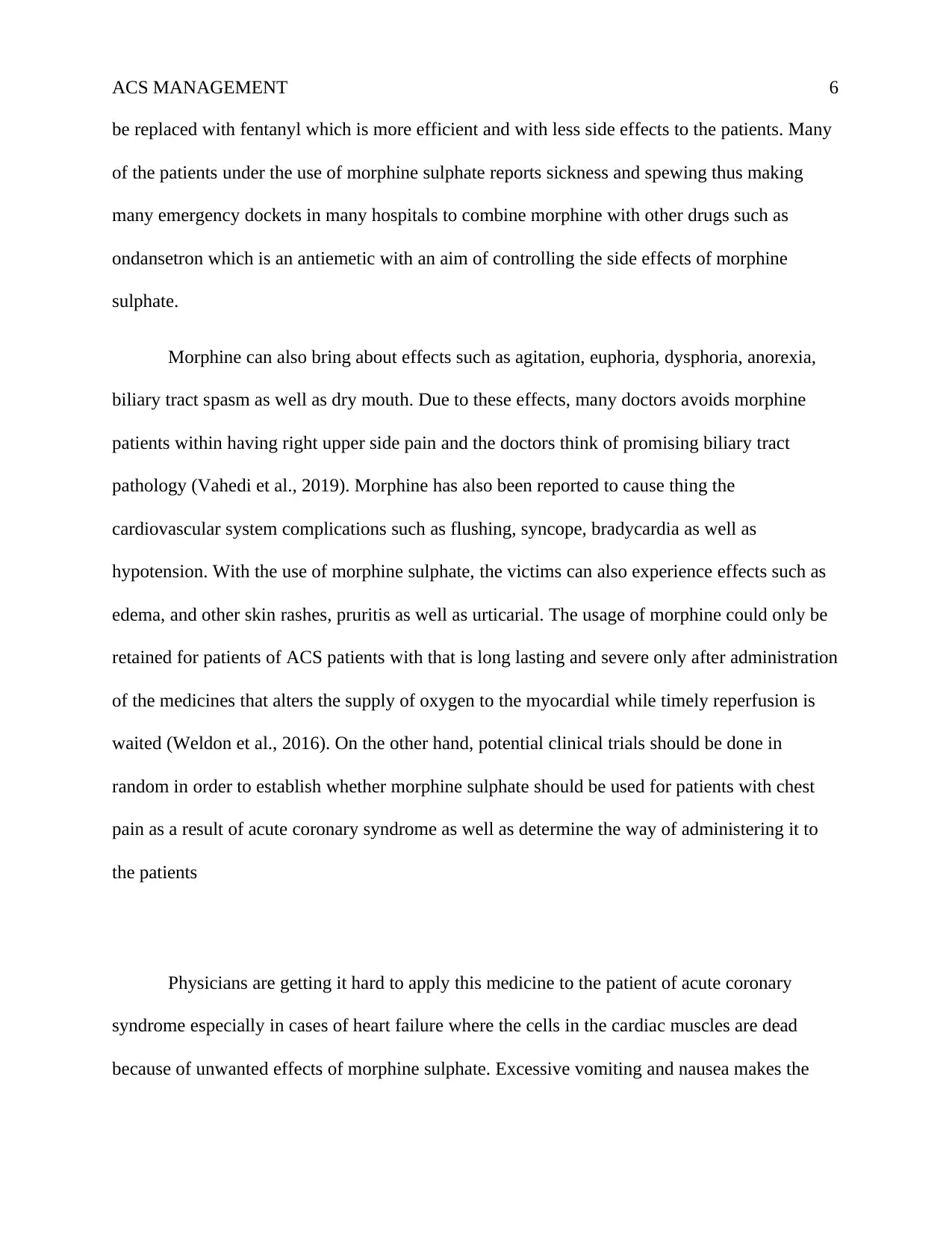
ACS MANAGEMENT 6
be replaced with fentanyl which is more efficient and with less side effects to the patients. Many
of the patients under the use of morphine sulphate reports sickness and spewing thus making
many emergency dockets in many hospitals to combine morphine with other drugs such as
ondansetron which is an antiemetic with an aim of controlling the side effects of morphine
sulphate.
Morphine can also bring about effects such as agitation, euphoria, dysphoria, anorexia,
biliary tract spasm as well as dry mouth. Due to these effects, many doctors avoids morphine
patients within having right upper side pain and the doctors think of promising biliary tract
pathology (Vahedi et al., 2019). Morphine has also been reported to cause thing the
cardiovascular system complications such as flushing, syncope, bradycardia as well as
hypotension. With the use of morphine sulphate, the victims can also experience effects such as
edema, and other skin rashes, pruritis as well as urticarial. The usage of morphine could only be
retained for patients of ACS patients with that is long lasting and severe only after administration
of the medicines that alters the supply of oxygen to the myocardial while timely reperfusion is
waited (Weldon et al., 2016). On the other hand, potential clinical trials should be done in
random in order to establish whether morphine sulphate should be used for patients with chest
pain as a result of acute coronary syndrome as well as determine the way of administering it to
the patients
Physicians are getting it hard to apply this medicine to the patient of acute coronary
syndrome especially in cases of heart failure where the cells in the cardiac muscles are dead
because of unwanted effects of morphine sulphate. Excessive vomiting and nausea makes the
be replaced with fentanyl which is more efficient and with less side effects to the patients. Many
of the patients under the use of morphine sulphate reports sickness and spewing thus making
many emergency dockets in many hospitals to combine morphine with other drugs such as
ondansetron which is an antiemetic with an aim of controlling the side effects of morphine
sulphate.
Morphine can also bring about effects such as agitation, euphoria, dysphoria, anorexia,
biliary tract spasm as well as dry mouth. Due to these effects, many doctors avoids morphine
patients within having right upper side pain and the doctors think of promising biliary tract
pathology (Vahedi et al., 2019). Morphine has also been reported to cause thing the
cardiovascular system complications such as flushing, syncope, bradycardia as well as
hypotension. With the use of morphine sulphate, the victims can also experience effects such as
edema, and other skin rashes, pruritis as well as urticarial. The usage of morphine could only be
retained for patients of ACS patients with that is long lasting and severe only after administration
of the medicines that alters the supply of oxygen to the myocardial while timely reperfusion is
waited (Weldon et al., 2016). On the other hand, potential clinical trials should be done in
random in order to establish whether morphine sulphate should be used for patients with chest
pain as a result of acute coronary syndrome as well as determine the way of administering it to
the patients
Physicians are getting it hard to apply this medicine to the patient of acute coronary
syndrome especially in cases of heart failure where the cells in the cardiac muscles are dead
because of unwanted effects of morphine sulphate. Excessive vomiting and nausea makes the
You're viewing a preview
Unlock full access by subscribing today!
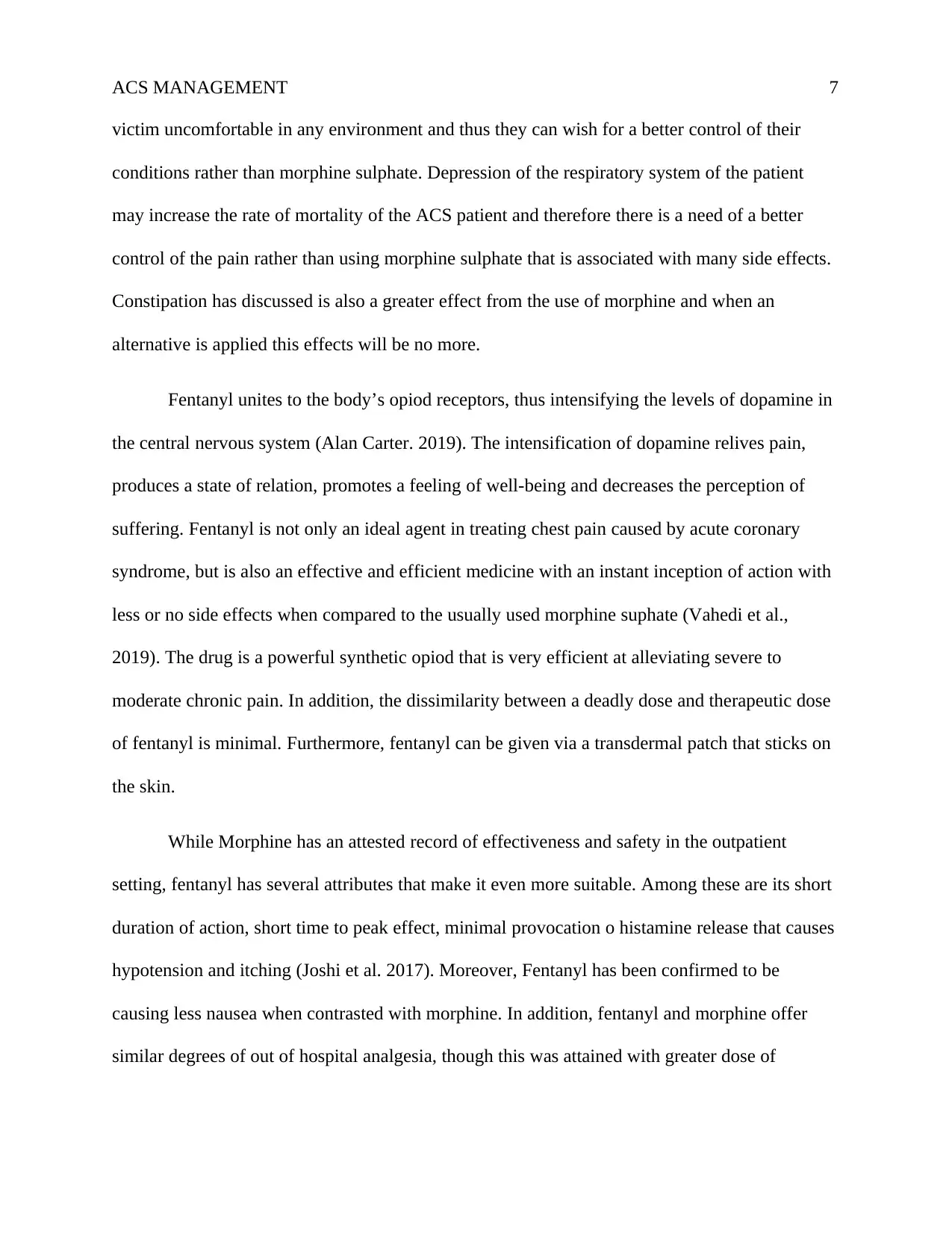
ACS MANAGEMENT 7
victim uncomfortable in any environment and thus they can wish for a better control of their
conditions rather than morphine sulphate. Depression of the respiratory system of the patient
may increase the rate of mortality of the ACS patient and therefore there is a need of a better
control of the pain rather than using morphine sulphate that is associated with many side effects.
Constipation has discussed is also a greater effect from the use of morphine and when an
alternative is applied this effects will be no more.
Fentanyl unites to the body’s opiod receptors, thus intensifying the levels of dopamine in
the central nervous system (Alan Carter. 2019). The intensification of dopamine relives pain,
produces a state of relation, promotes a feeling of well-being and decreases the perception of
suffering. Fentanyl is not only an ideal agent in treating chest pain caused by acute coronary
syndrome, but is also an effective and efficient medicine with an instant inception of action with
less or no side effects when compared to the usually used morphine suphate (Vahedi et al.,
2019). The drug is a powerful synthetic opiod that is very efficient at alleviating severe to
moderate chronic pain. In addition, the dissimilarity between a deadly dose and therapeutic dose
of fentanyl is minimal. Furthermore, fentanyl can be given via a transdermal patch that sticks on
the skin.
While Morphine has an attested record of effectiveness and safety in the outpatient
setting, fentanyl has several attributes that make it even more suitable. Among these are its short
duration of action, short time to peak effect, minimal provocation o histamine release that causes
hypotension and itching (Joshi et al. 2017). Moreover, Fentanyl has been confirmed to be
causing less nausea when contrasted with morphine. In addition, fentanyl and morphine offer
similar degrees of out of hospital analgesia, though this was attained with greater dose of
victim uncomfortable in any environment and thus they can wish for a better control of their
conditions rather than morphine sulphate. Depression of the respiratory system of the patient
may increase the rate of mortality of the ACS patient and therefore there is a need of a better
control of the pain rather than using morphine sulphate that is associated with many side effects.
Constipation has discussed is also a greater effect from the use of morphine and when an
alternative is applied this effects will be no more.
Fentanyl unites to the body’s opiod receptors, thus intensifying the levels of dopamine in
the central nervous system (Alan Carter. 2019). The intensification of dopamine relives pain,
produces a state of relation, promotes a feeling of well-being and decreases the perception of
suffering. Fentanyl is not only an ideal agent in treating chest pain caused by acute coronary
syndrome, but is also an effective and efficient medicine with an instant inception of action with
less or no side effects when compared to the usually used morphine suphate (Vahedi et al.,
2019). The drug is a powerful synthetic opiod that is very efficient at alleviating severe to
moderate chronic pain. In addition, the dissimilarity between a deadly dose and therapeutic dose
of fentanyl is minimal. Furthermore, fentanyl can be given via a transdermal patch that sticks on
the skin.
While Morphine has an attested record of effectiveness and safety in the outpatient
setting, fentanyl has several attributes that make it even more suitable. Among these are its short
duration of action, short time to peak effect, minimal provocation o histamine release that causes
hypotension and itching (Joshi et al. 2017). Moreover, Fentanyl has been confirmed to be
causing less nausea when contrasted with morphine. In addition, fentanyl and morphine offer
similar degrees of out of hospital analgesia, though this was attained with greater dose of
Paraphrase This Document
Need a fresh take? Get an instant paraphrase of this document with our AI Paraphraser
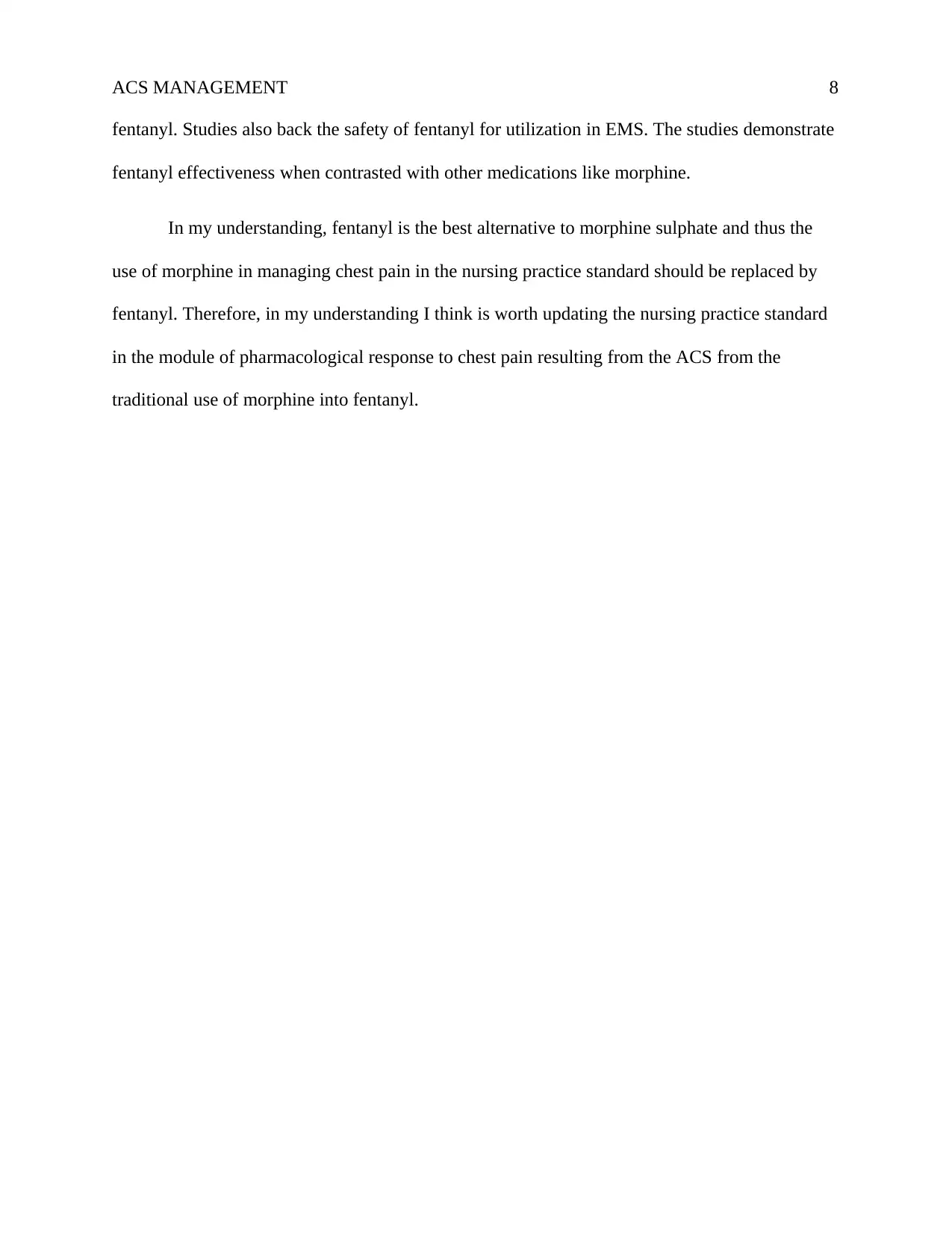
ACS MANAGEMENT 8
fentanyl. Studies also back the safety of fentanyl for utilization in EMS. The studies demonstrate
fentanyl effectiveness when contrasted with other medications like morphine.
In my understanding, fentanyl is the best alternative to morphine sulphate and thus the
use of morphine in managing chest pain in the nursing practice standard should be replaced by
fentanyl. Therefore, in my understanding I think is worth updating the nursing practice standard
in the module of pharmacological response to chest pain resulting from the ACS from the
traditional use of morphine into fentanyl.
fentanyl. Studies also back the safety of fentanyl for utilization in EMS. The studies demonstrate
fentanyl effectiveness when contrasted with other medications like morphine.
In my understanding, fentanyl is the best alternative to morphine sulphate and thus the
use of morphine in managing chest pain in the nursing practice standard should be replaced by
fentanyl. Therefore, in my understanding I think is worth updating the nursing practice standard
in the module of pharmacological response to chest pain resulting from the ACS from the
traditional use of morphine into fentanyl.
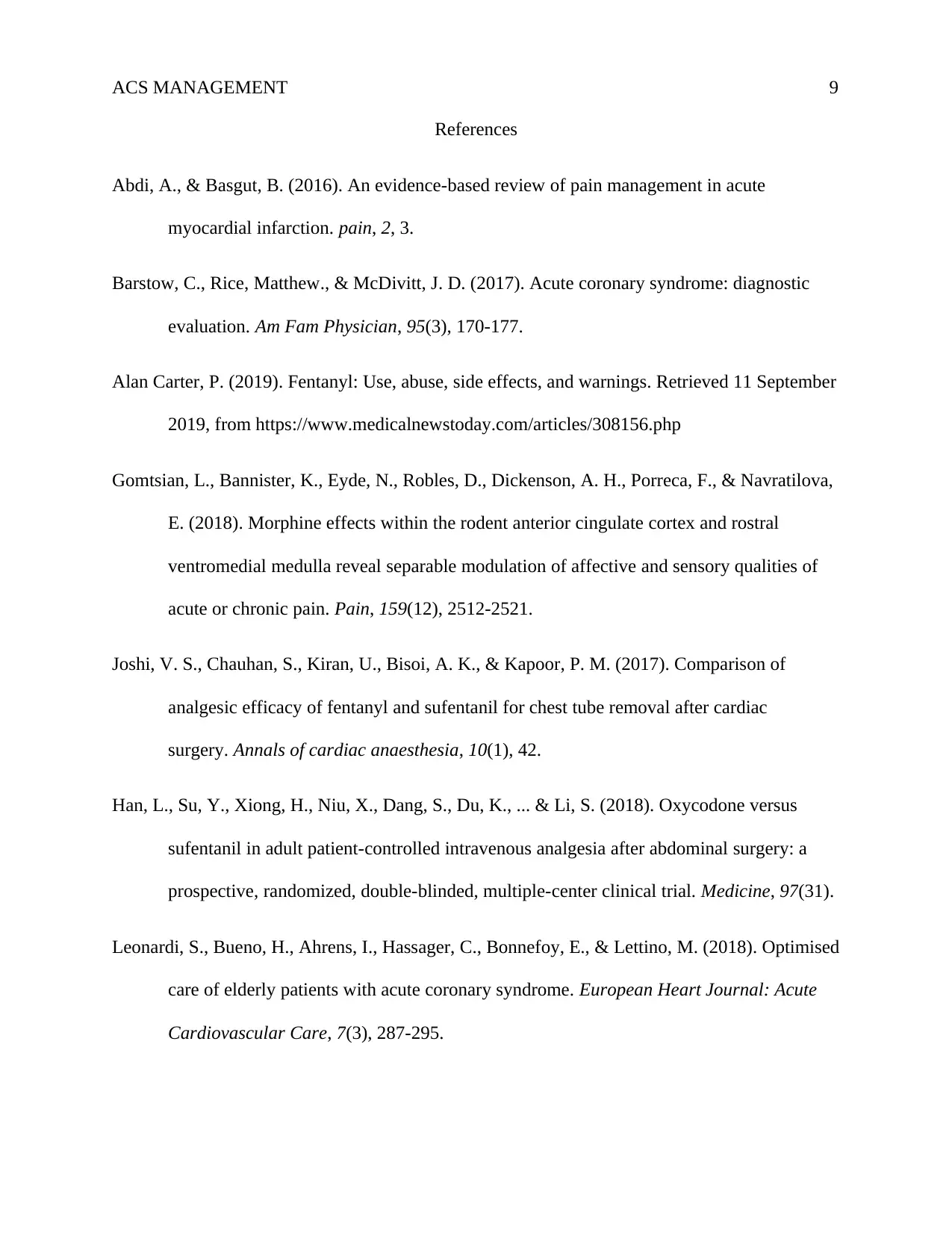
ACS MANAGEMENT 9
References
Abdi, A., & Basgut, B. (2016). An evidence-based review of pain management in acute
myocardial infarction. pain, 2, 3.
Barstow, C., Rice, Matthew., & McDivitt, J. D. (2017). Acute coronary syndrome: diagnostic
evaluation. Am Fam Physician, 95(3), 170-177.
Alan Carter, P. (2019). Fentanyl: Use, abuse, side effects, and warnings. Retrieved 11 September
2019, from https://www.medicalnewstoday.com/articles/308156.php
Gomtsian, L., Bannister, K., Eyde, N., Robles, D., Dickenson, A. H., Porreca, F., & Navratilova,
E. (2018). Morphine effects within the rodent anterior cingulate cortex and rostral
ventromedial medulla reveal separable modulation of affective and sensory qualities of
acute or chronic pain. Pain, 159(12), 2512-2521.
Joshi, V. S., Chauhan, S., Kiran, U., Bisoi, A. K., & Kapoor, P. M. (2017). Comparison of
analgesic efficacy of fentanyl and sufentanil for chest tube removal after cardiac
surgery. Annals of cardiac anaesthesia, 10(1), 42.
Han, L., Su, Y., Xiong, H., Niu, X., Dang, S., Du, K., ... & Li, S. (2018). Oxycodone versus
sufentanil in adult patient-controlled intravenous analgesia after abdominal surgery: a
prospective, randomized, double-blinded, multiple-center clinical trial. Medicine, 97(31).
Leonardi, S., Bueno, H., Ahrens, I., Hassager, C., Bonnefoy, E., & Lettino, M. (2018). Optimised
care of elderly patients with acute coronary syndrome. European Heart Journal: Acute
Cardiovascular Care, 7(3), 287-295.
References
Abdi, A., & Basgut, B. (2016). An evidence-based review of pain management in acute
myocardial infarction. pain, 2, 3.
Barstow, C., Rice, Matthew., & McDivitt, J. D. (2017). Acute coronary syndrome: diagnostic
evaluation. Am Fam Physician, 95(3), 170-177.
Alan Carter, P. (2019). Fentanyl: Use, abuse, side effects, and warnings. Retrieved 11 September
2019, from https://www.medicalnewstoday.com/articles/308156.php
Gomtsian, L., Bannister, K., Eyde, N., Robles, D., Dickenson, A. H., Porreca, F., & Navratilova,
E. (2018). Morphine effects within the rodent anterior cingulate cortex and rostral
ventromedial medulla reveal separable modulation of affective and sensory qualities of
acute or chronic pain. Pain, 159(12), 2512-2521.
Joshi, V. S., Chauhan, S., Kiran, U., Bisoi, A. K., & Kapoor, P. M. (2017). Comparison of
analgesic efficacy of fentanyl and sufentanil for chest tube removal after cardiac
surgery. Annals of cardiac anaesthesia, 10(1), 42.
Han, L., Su, Y., Xiong, H., Niu, X., Dang, S., Du, K., ... & Li, S. (2018). Oxycodone versus
sufentanil in adult patient-controlled intravenous analgesia after abdominal surgery: a
prospective, randomized, double-blinded, multiple-center clinical trial. Medicine, 97(31).
Leonardi, S., Bueno, H., Ahrens, I., Hassager, C., Bonnefoy, E., & Lettino, M. (2018). Optimised
care of elderly patients with acute coronary syndrome. European Heart Journal: Acute
Cardiovascular Care, 7(3), 287-295.
You're viewing a preview
Unlock full access by subscribing today!
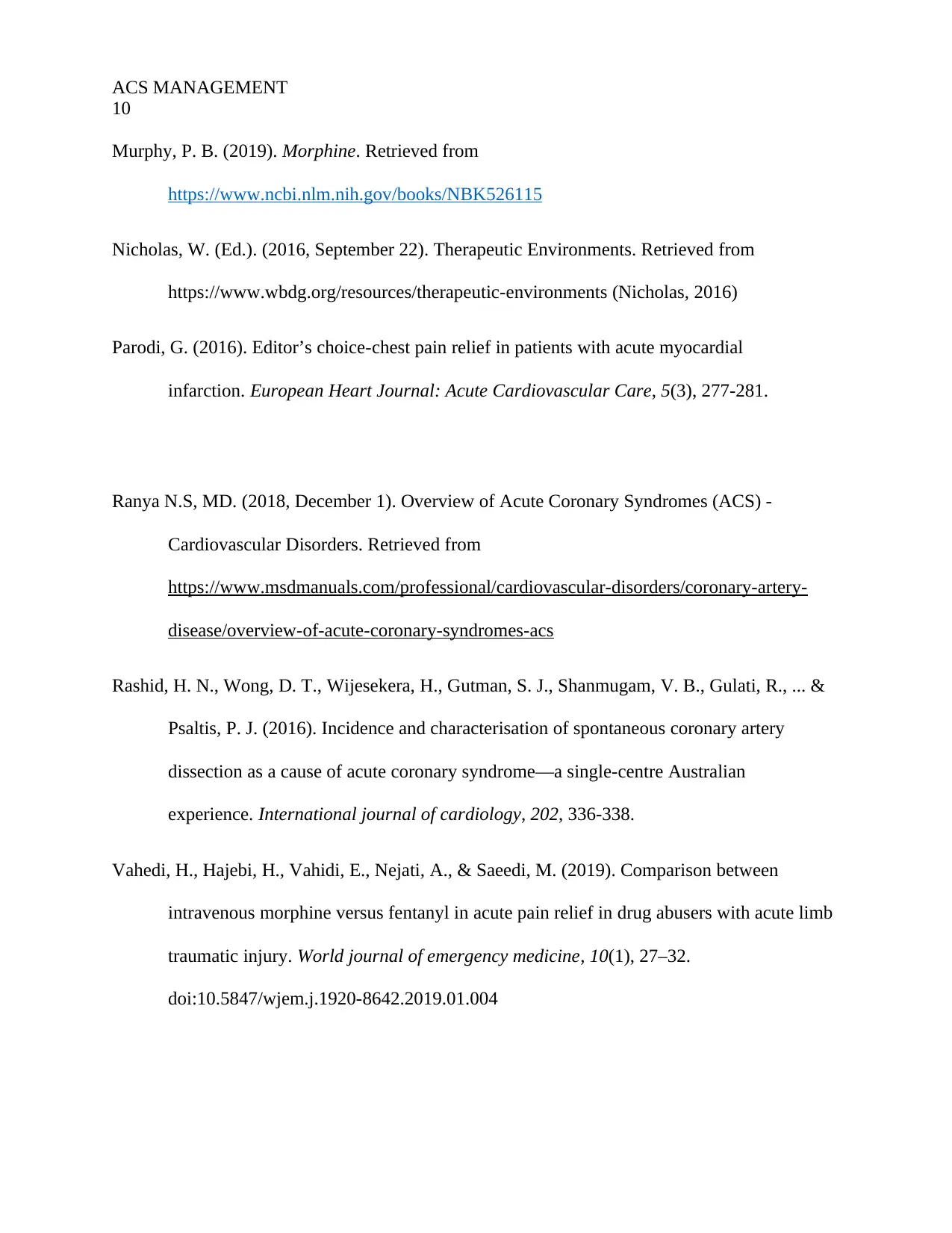
ACS MANAGEMENT
10
Murphy, P. B. (2019). Morphine. Retrieved from
https://www.ncbi.nlm.nih.gov/books/NBK526115
Nicholas, W. (Ed.). (2016, September 22). Therapeutic Environments. Retrieved from
https://www.wbdg.org/resources/therapeutic-environments (Nicholas, 2016)
Parodi, G. (2016). Editor’s choice-chest pain relief in patients with acute myocardial
infarction. European Heart Journal: Acute Cardiovascular Care, 5(3), 277-281.
Ranya N.S, MD. (2018, December 1). Overview of Acute Coronary Syndromes (ACS) -
Cardiovascular Disorders. Retrieved from
https://www.msdmanuals.com/professional/cardiovascular-disorders/coronary-artery-
disease/overview-of-acute-coronary-syndromes-acs
Rashid, H. N., Wong, D. T., Wijesekera, H., Gutman, S. J., Shanmugam, V. B., Gulati, R., ... &
Psaltis, P. J. (2016). Incidence and characterisation of spontaneous coronary artery
dissection as a cause of acute coronary syndrome—a single-centre Australian
experience. International journal of cardiology, 202, 336-338.
Vahedi, H., Hajebi, H., Vahidi, E., Nejati, A., & Saeedi, M. (2019). Comparison between
intravenous morphine versus fentanyl in acute pain relief in drug abusers with acute limb
traumatic injury. World journal of emergency medicine, 10(1), 27–32.
doi:10.5847/wjem.j.1920-8642.2019.01.004
10
Murphy, P. B. (2019). Morphine. Retrieved from
https://www.ncbi.nlm.nih.gov/books/NBK526115
Nicholas, W. (Ed.). (2016, September 22). Therapeutic Environments. Retrieved from
https://www.wbdg.org/resources/therapeutic-environments (Nicholas, 2016)
Parodi, G. (2016). Editor’s choice-chest pain relief in patients with acute myocardial
infarction. European Heart Journal: Acute Cardiovascular Care, 5(3), 277-281.
Ranya N.S, MD. (2018, December 1). Overview of Acute Coronary Syndromes (ACS) -
Cardiovascular Disorders. Retrieved from
https://www.msdmanuals.com/professional/cardiovascular-disorders/coronary-artery-
disease/overview-of-acute-coronary-syndromes-acs
Rashid, H. N., Wong, D. T., Wijesekera, H., Gutman, S. J., Shanmugam, V. B., Gulati, R., ... &
Psaltis, P. J. (2016). Incidence and characterisation of spontaneous coronary artery
dissection as a cause of acute coronary syndrome—a single-centre Australian
experience. International journal of cardiology, 202, 336-338.
Vahedi, H., Hajebi, H., Vahidi, E., Nejati, A., & Saeedi, M. (2019). Comparison between
intravenous morphine versus fentanyl in acute pain relief in drug abusers with acute limb
traumatic injury. World journal of emergency medicine, 10(1), 27–32.
doi:10.5847/wjem.j.1920-8642.2019.01.004
Paraphrase This Document
Need a fresh take? Get an instant paraphrase of this document with our AI Paraphraser

ACS MANAGEMENT
11
Weldon, E. R., Ariano, R. E., & Grierson, R. A. (2016). Comparison of fentanyl and morphine in
the prehospital treatment of ischemic type chest pain. Prehospital Emergency
Care, 20(1), 45-51.
11
Weldon, E. R., Ariano, R. E., & Grierson, R. A. (2016). Comparison of fentanyl and morphine in
the prehospital treatment of ischemic type chest pain. Prehospital Emergency
Care, 20(1), 45-51.
1 out of 11
Related Documents
Your All-in-One AI-Powered Toolkit for Academic Success.
+13062052269
info@desklib.com
Available 24*7 on WhatsApp / Email
![[object Object]](/_next/static/media/star-bottom.7253800d.svg)
Unlock your academic potential
© 2024 | Zucol Services PVT LTD | All rights reserved.





